2021 Arrivals
Happy Return
We were quite surprised in February 2021 to see Jemima and her drake in the garden again. We had thought that the previous years 'capture and release' would have put her off returning. She was obviously not that much perturbed, and we do read that Mallards will return to the place where they successfully nested before.
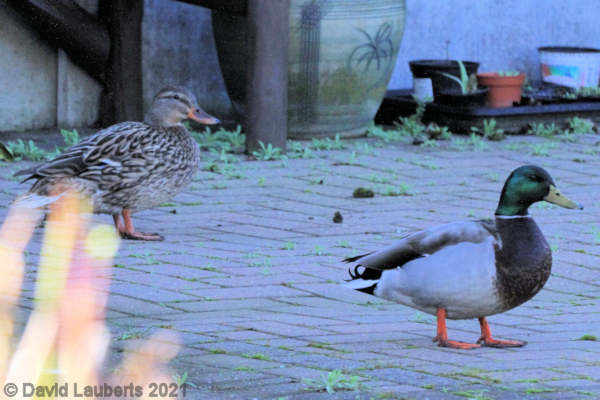
First 2021 sighting of Jemima 10am 26th Feb 2021
It was actually quite an uplift for us as we were now part way through the UK's second Coronavirus 'lockdown' and it was quite exciting that we could follow her nesting, laying eggs, hatching and seeing her 2021 brood of ducklings. We watched her avidly when she was here to see where she nested and also started planning how we would capture and release them once they had hatched. My sister-in-law even started writing updates on the ducks in her school newsletter, apparently it was a topic everyone there was very interested in in these trying and restrictive times.
Reading around Mallard courtship we found that ducks generally pair with a new drake every year, usually in October for the following year and over winter together. The duck generally returns to where she successfully hatched her eggs the previous year.
Though we first saw her on the 26th of February it seemed a few weeks before they be she finally decided to nest in our garden. The pair would disappear for a few days and then re-appear again. Whether they were looking at other sites, or just periodically coming back to check out their preferred spot I don't know.
When we saw them, the pair seemed very settled and attentive of each other.
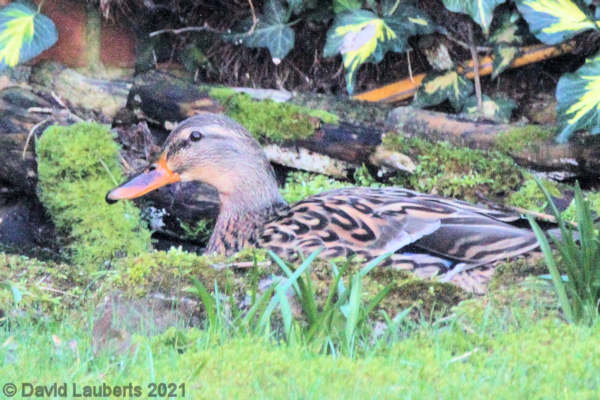
Jemima 26th Feb 2021
It was interesting that at first they were more interested in exploring the garden, it was not till after a few weeks that we saw them starting to explore what would be the nest site.
Nesting
This would be in an ivy bush, with laurel and Russian ivy, on a 5-foot brick wall. It was under the place we used to see her fly onto the previous year and was likely where she nested before. Though I had looked onto top of the ivy after she had left in 2020, we never found her nest, we didn't actually look very hard in the bush, it just seemed impossibly that she could get in there.
Because the ivy had been started to become overgrown, we had cut it back a bit on our side, even then I cannot recall seeing any signs of a nest on the wall.
One day early in March we watched Jemima land on top of the 7 foot ivy hedge and pick her way all along it, diving down a couple of feet in a couple of places through the greenery and onto the wall along its entire length.
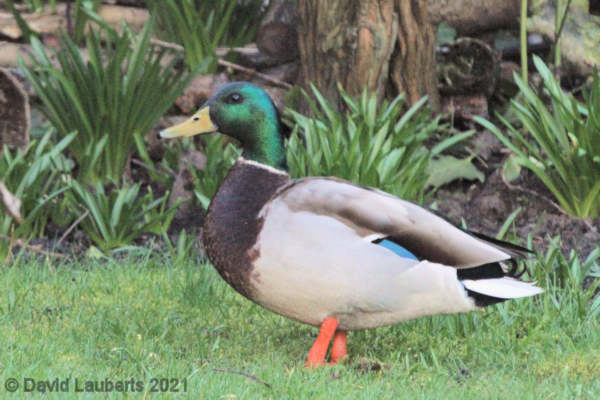
Jemima's partner drake 26th Feb 2021
While she was doing this the drake flew onto the hedge where Jemima would eventually make her nest this year. The house at the bottom of the garden has a cat, ('Pretty cat' we call it). This decided to make an appearance while the ducks were on the hedge, Jemima had just got to the end of the wall and jumped on to one of our sheds. This was the first time we saw ducks go into 'hide' mode. They both sank as far as they could on to the ground they were on the heads and necks down and as still as they could be. The cat didn't seem to notice them and slinked away.
The pair kept popping back over the next few weeks, she would explore the nest site, the drake would stand around in the garden trying to play 'I'm not really here and if you can see me I'm getting pretty bored'. They would wander from pond to pond and dose on wall by the pond, wandering about on and off the net.
Because they were only about for a very short while we were able to see where she was potentially going to nest and installed a 'birdbox' camera on the wall looking over the area where she was going to nest. We were able to see her 'live' by Wi-Fi either on our phones via an app or on the computer, when she was on the nest and look at recording the camera saved on its Micro SD card. The software allowed us to download videos of anything of interest. We also had a few 'trial' cameras around the garden to see what the hedgehogs, mice, frogs, and cats were up to at night.
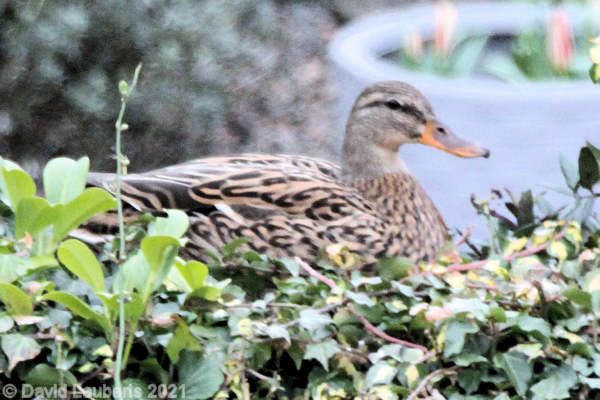
Jemima exploring the ivy 6th March 2021
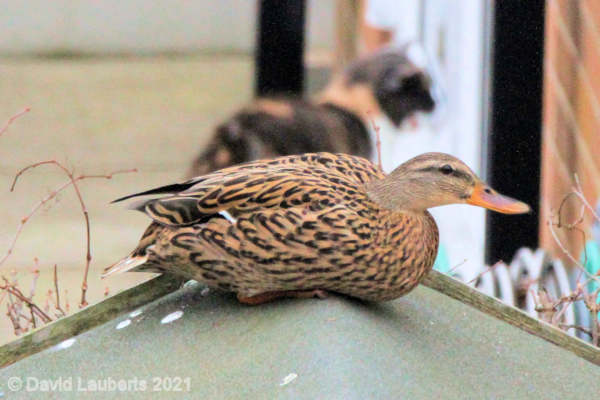
Jemima playing 'You can't see me Mr Cat!' 6th March 2021
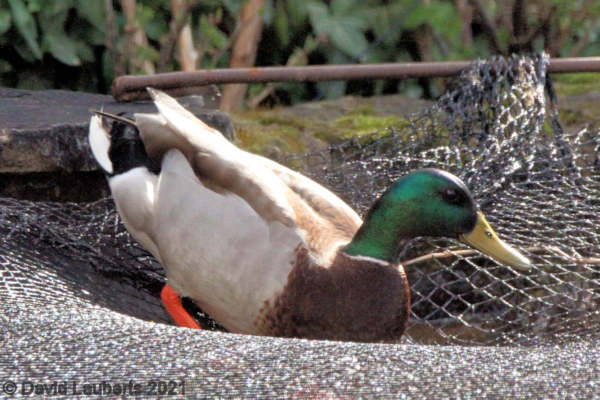
Daddy testing the net 12th March 2021
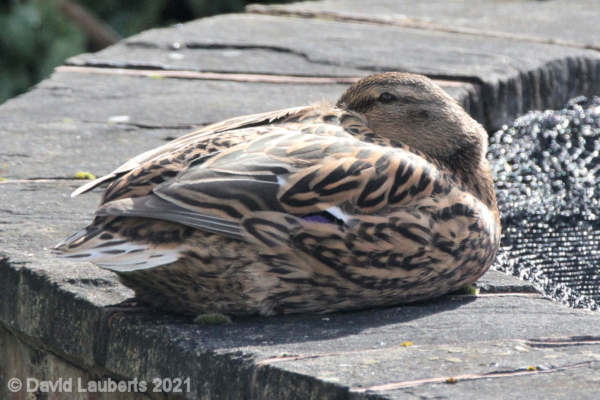
Catching a few z's 12th March 2021
Egg laying
The first we knew that she had laid any eggs was from watching the video footage. It was amazing to see the bright blue eggs under her body! There were two eggs, whether she laid both at that day or one the day before, and we had missed it, we don't know.
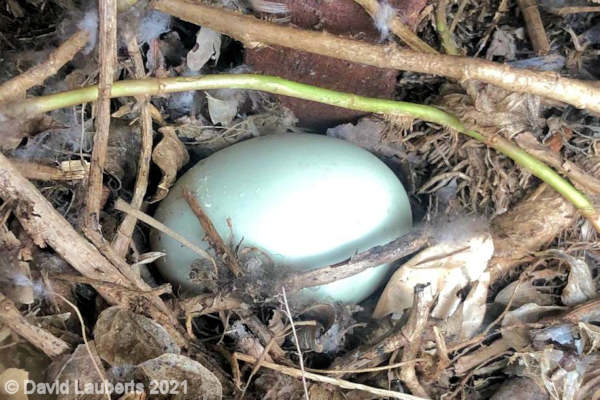
Mallard Egg=
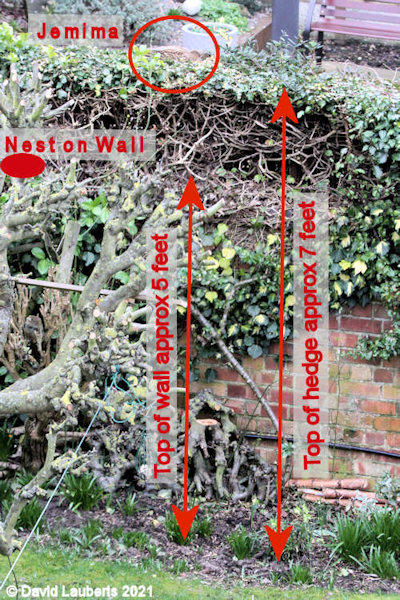
Jemima's nest on the wall March 2021
You should note that in the UK, Mallards and their nests are protected by the Wildlife and Countryside Act 1981, which makes it an offence to intentionally kill, injure or take any wild bird, or to take, damage or destroy its nest, eggs or young.
Therefore, it is important not to chase away a duck that has started nesting, since she must be allowed access to her nest.
Each day, over the next few weeks, she would appear at around 8 am (though it did vary), usually landing in the main pond. Sometimes her drake was with her, sometimes she was alone. We had removed the heron net for her (when we thought about it the heron had not been around for some time). She would then jump onto the pond wall and look around for a short while and then fly to the top of the ivy hedge as she had done the previous year. At this point if the drake was with her, he would fly off. This time we could study what she was doing with binoculars and cameras.
Once on the top of the hedge she would look around to make sure nothing was looking and then dive down a couple of feet through the hedge to the top of the wall and then about a couple of feet back along it to her nest. In all the time we watched her, she never tried to get into the nest from the side, only by dropping down through the hedge from the top. She would stay for an hour or so, laying an egg (we assume - we only ever saw her 'lay' one via the camera) and then, having covered her eggs with any loose leaves or down plucked from her chest, she would exit from the wall sideways, sometimes becoming entangled in the bush adjacent to it and either fly to the pond for a short while or swooping round and off straight away. For that period, she was only on the nest for about an hour, once a day.
An important note for anybody who finds a duck nest in the wild is DO NOT DISTURB IT! Leave it alone, it may NOT be abandoned. The mother may be in the process of adding eggs to her clutch daily and be away from her 'hidden' nest or be just away for a short time while she is incubating for a little food and rest and to wet her feathers.
It was quite comical sometimes watching her enter and leave her nest. There are links to some videos below of here entering and leaving, as well as laying an egg!